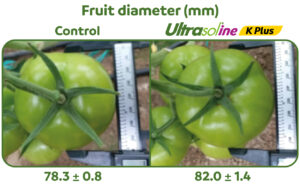Nutrient demands
Modern tomato cultivars are heavy mineral feeders. They consume high amounts of mineral nutrients and reward the grower with bountiful yields. As tomato fruits are rich in sugars and organic acids, their production requires rich potassium nutrition, because this element is very instrumental in the synthesis of these fruit ingredients.
Nutrient removal by fresh tomato fruits

Total K2O removal by tomatoes is more than two-fold higher than that of N
The specific effects of the nutrients on tomato yield and quality

Summary of main nutrient functions
Each element has specific functions within the tomato plant morphology and functioning, and in most cases several elements participate in various stages of the same process. So, it can be schematically summarized as follows.
Nutrient | Main functions in the tomato plant |
Nitrogen | Synthesis of structural and functional proteins (enzymes). Nitrate participates in the formation of cytokinins. |
Phosphorus | Development of the root system, especially on seeds and transplants. Energy requiring processes (ATP). Cell division. |
Potassium | Source-to-sink carbohydrate transportation. Important osmoticum factor. Stomata control. Photosynthesis enhancement. Enhancement of resistance to diseases and pests. |
Calcium | Plant structural firmness. Improved post-harvest storage, and reduced susceptibility to diseases. |
Magnesium | The central atom of the chlorophyll molecule. |
Sulphur | Synthesis of the essential amino acids, cysteine and methionine. Enhancement of resistance to diseases and pests. |
Iron | Chlorophyll synthesis process and a constituent of many enzymes e.g. peroxidase, catalase in the nutritional metabolism of the tomato plant. |
Manganese | Photosynthesis process. |
Boron | Cell walls and membranes formation (pectin and lignin). Metabolism and transport of carbohydrates. Flowering, fruit-set and seed development. |
Zinc | Auxins synthesis. Also, a constituent of the enzyme carbonic anhydrase, essential for metabolism of nutrients in tomato. |
Copper | Metabolism of nitrogen and carbohydrates. |
Molybdenum | N metabolism in the tomato plant, a central part of the nitrate-reductase enzyme. |
Phenological growth stages

Nutrients uptake dynamics
The following figure represents the uptake dynamics of Nitrogen (N), Phosphorus (P) and potassium (K), of a determinate field tomato cultivar, with an expected yield of 90 MT/ha, throughout its entire life cycle.

In the first growing stage, the transplant or the seed must develop a substantial root system, which will support the development of the stems and foliage, which are the precondition for carrying the plant's yield. All three macro nutrients, i.e. N, P and K, should be available at sufficient amounts to enable the development of this root system. It should also be stressed in this regard, that the ideal form of nitrogen, to be supplied throughout the growth cycle of the tomato crop, is nitrate (NO3+).
The maximum share of ammoniacal nitrogen that the plant can take without reduced performance is 20% under field conditions, and merely 5-7% under hydroponic nutrition, (Voogt, 2002). Once the plant has developed sufficient root system, and above-ground biomass, it starts producing flowers, which rapidly develop into the first fruitlets, and they, in turn, start a long process of development and accumulation of sugars, organic acids, vitamins, pigments and anti-oxidants that enrich this fruit with their specific health values.
Now, as can be seen in the above scheme of the uptake curves in the following tables, the requirement for potassium keeps growing throughout the growth cycle of the tomato plant. The clear solution for these two requirements is the application of potassium nitrate, which is the only straight binary fertilizer that combines both these nutrients. Naturally, other nitrate carrying fertilizers should supply the additional nitrate- nitrogen required. These are calcium nitrate, magnesium nitrate and ammonium nitrate. Also, during this period of rapid fruit growth, fully soluble fertilizers are crucial for ensuring that a nutritional supply is available during the bulking up of the fruits.
The following plan is suggested for realizing the said requirements, for a determinate cultivar of field tomatoes with a life span of 140 days, and an expected yield of 100 MT/ha, by fertigation via drip irrigation.
The relative shares of nutrients to be applied according to the indicated phenological growth stages of the tomato crop, for an intended yield of 100 MT/ha, by fertigation via drip irrigation.

*DAT= Days after transplanting
The actual rates of nutrients to be applied at the different phenological growth stages of the tomato crop, for an intended yield of 100 MT/ha, by fertigation via drip irrigation.

Growth stage (DAT) | Explanation of the changes in the demand dynamics |
0-28 | Relatively balanced rates of N, P, K and Ca, for establishing root system and building shoot biomass. |
29-63 | Much higher N demand for producing the flowers, the fruit-set and fruit early development stages. P requirement remains stable at this time for early seed formation; Very high K demand for fruit formation and its bulking up. Increased demand for Ca, Mg and S, for continued vegetative development. |
64-110 | A slight reduction in the vegetative development dictates somewhat lower N requirement. Stable P demand. All other nutrients (K, Ca, Mg and S) show the same pattern as the nitrogen, i.e. stable and slightly lower demand for the lower pace of vegetative and regenerative organs. |
111-140 | Markedly reduced requirement for all nutrients, due to markedly lower production of shoots and fruits. The highest demand is for K (K:N = 3:1), which is required for the continued bulking up of the developing fruits. |



